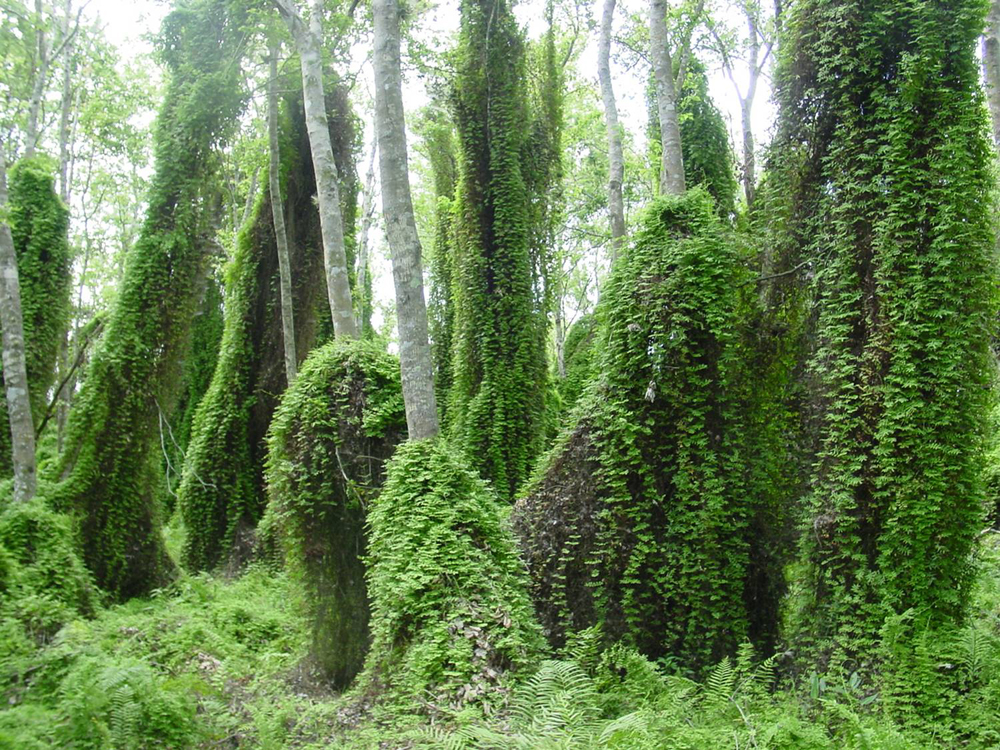Lygodium microphyllum
Old World climbing fern
Synonym(s): Lygodium scandens
Class: Pteridopsida
Order: Schizaeales
Family: Lygodiaceae
Duration and Habit: Perennial fern

Photographer: unknown
Source: http://pesticide.ifas.ufl.edu/Lygodium/photo_gallery/lygodium.shtml
Description
The Old World climbing fern (Lygodium scandens) is a green to dark brown climbing fern found attached to trees and other native vegetation. The wiry rhizomes found branching off of the main rachis can be 90 to 100 feet long. Smaller leafy branches extend off of the main rachis measuring 2 to 5 inches. Leaflets form off of the smaller branches that are glabrous, unlobed, and fringed.
Ecological Threat: The Old World climbing fern is found growing in forests where it has become attached to trees and climbs up the entire length of the tree to reach sunlight at the top. With the ability to resprout from any point along the vine, the Old World climbing fern is able to form dense nets across trees and other vegetation. The dense mat that is formed by the fern creates a high potential for fires. The additional risk for fires can change natural physical processes that native plants are accustomed to.
Biology & Spread: The Old World fern is able to resprout from almost any part of the climbing vine, allowing for rapid growth and expansion across a tree. There are two types of leaflets that branch off the main climbing vine, the normal vegetative leaflet and the convoluted leaflet with sporangia. The sporangia found along the margin of the leaves forms gametophytes followed by the formation of a new climbing fern. Typical with most climbing ferns, the Old World fern alternates between vegetative and reproductive forms.
History: The Old World climbing fern was first discovered in Florida in 1965 and was introduced purposely from Asia as an ornamental plant. Being an aggressive grower, the Old World climbing fern quickly grew out of control and became established in many states throughout the south and east United States.
U.S. Habitat: The Old World climbing fern is found in warmer southern climates growing on trees and other vegetation. Wet areas such as wet prairies and saw grass marshes are common places that the invasive fern can be found growing on the ground or attached to bald cypress stands.
Distribution
Native Origin: Asia and Australia
U.S. Present: AL, CT, DE, FL, GA, IN, KY, MA, MD, MI, MS, NC, NH, NJ, NY, OH, PA, RI, SC, TN, VA, VT, WA
Management
Preventative management is the most important in controlling the spread of the Old World climbing fern. Monitoring and ensuring early detection of invasion in new areas can help local wildlife authorities contain the invasive plant quickly and economically. Eradication by mechanical methods of pulling Old World climbing fern is effective in areas with little establishment. Mowing is only temporarily effective in removing the invasive fern. Chemical treatment with a 2 to 3 % solution of glyphosate (Roundup) is effective. Metsulfuron (Escort), also provides control at rates of 0.5 to 1 oz. per acre. A combination of these herbicides is effective when applied in the fall prior to a killing frost.
Text References
Beckner, J. 1068. Lygodium microphyllum, another fern escaped in Florida. American Fern Journal 58:93-94.
Nauman, C. E., and D. F. Austin. 1978. Spread of the exotic fern Lygodium microphyllum in Florida. American Fern Journal 68:65-66.
Internet Sources
http://www.sms.si.edu/irlspec/lygodium_microphyllum.htm
 Texas Invasive Species Institute
Texas Invasive Species Institute